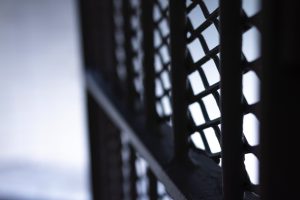By Maya Richard-Craven
As we march into what climate scientists predict could be one of the hottest years on record, plenty of us will be cranking up the air conditioning, sitting in front of a fan, or sweating on our front porches.
But imagine the torment of trying to find relief by lying on a cold prison floor or cooling off with toilet water.
This is not a scene from a dystopian novel. It’s a reality for people experiencing the suffocating confines of incarceration.
Temperatures within America’s prison walls are often unbearable. And, given the unjust demographics of who gets locked up in the United States — 38.5% of incarcerated people are Black, even though we only make up 13.6% of the population — hot prisons disproportionately impact Black incarcerated individuals.
“A lot of times, these buildings are not designed with climate control in mind,” says David Dosa, an associate professor of medicine, health services, policy, and practice at Brown University.
Dosa has studied heat in prisons for the past three years and is the co-author of a 2022 study about extreme heat in Texas prisons. Only 30% of living units in Texas prisons have air conditioning.
The problem is particularly acute in the South. As the Prison Policy Initiative reported in 2019, “Although 95% of households in the South use air conditioning, including 90% of households that make below $20,000 per year, states around the South have refused to install air conditioning in their prisons, creating unbearable and dangerous conditions for incarcerated people.”
It’s not just an issue of being hot and uncomfortable. Dosa and his fellow researchers found more people are dying in prisons without air conditioning compared to those with air conditioning.
“As heat increased, there was an increase in mortality,” he says.
As heat increased, there was an increase in mortality.DAVID DOSA, BROWN UNIVERSITY
Hot Prisons Aren’t a New Problem
Formerly incarcerated people say heat in prisons has been an issue for a long time. Marsha Curry-Nixon entered Muncy State Correctional Facility in 1994 for a year-long sentence. She says the Pennsylvania-based prison didn’t have air conditioning and didn’t permit fans.
“Serving time upstate in the dormitories, there was no air conditioning. At Muncy State Correctional Facility, the heat was unbearable. The windows were barred and not bringing in any breeze,” Curry-Nixon tells Word in Black.
Suicide rates in prisons increase as a result of extreme heat. The academic journal PLOS ONE published a study looking at deaths in private and state-run prisons during June, July, and August from 2001 to 2019. A 10-degree rise in temperature increased deaths by 5.2%.
Within three days of an extreme heat wave, researchers saw a 22.8% increase in suicides. Those with chronic health problems struggle to breathe. Some people can’t even afford to purchase towels from the commissary.
At Muncy State Correctional Facility, the heat was unbearable. The windows were barred and not bringing in any breeze.MARSHA CURRY-NIXON, AMIRACLE4SURE, INC.
How widespread is the problem? According to the Prison Policy Initiative’s 2019 report, at least 13 states — Alabama, Arizona, Florida, Georgia, Kansas, Kentucky, Louisiana, Mississippi, Missouri, North Carolina, South Carolina, Texas, and Virginia — do not have universal air conditioning in their carceral facilities.
But in an email to Word In Black, Wanda Bertram, a communications strategist for the Prison Policy Initiative, wrote that it’s “probably way more than 13.”
Bertram wrote that the 2019 report “was not a comprehensive review of states without universal A/C, just a review of states in the hottest parts of the country where we have sources showing a lack of A/C.”
In addition, Bertram wrote that she is “positive that many other states in less famously hot parts of the country lack universal A/C in prisons, simply because it hasn’t always been necessary.”
A Lack of Federal Regulation
Reporting by Vox in 2019 found that “there are no federal laws mandating temperature control in prisons and jails.”
In an email to Word In Black, Emery Nelson, a public affairs specialist for the Federal Bureau of Prisons, wrote that the bureau takes the impact of heat on incarcerated individuals seriously — people are “treated on a case-by-case basis.”
Nelson wrote that “Heat stroke is treated as a medical emergency and appropriate care is rendered to the inmate patients. There are nursing and paramedic protocols to treat heat-related illness, to include instructions for vital sign monitoring, interventions such as IV fluids and body cooling, as well as indications of when to transfer to a higher level of care.”
That raises the question — what was happening in December 2020 when Tommy Lee Rutledge, a 44-year-old Black man, died in an Alabama prison mental health ward from extreme heat? His body temperature reached 109 degrees, and a federal lawsuit brought after his death noted that “he was literally baked to death in his cell.”
How many other Black people in Alabama could be in the same situation? In 2017, Black people made up 28% of the population in the state and 54% of people in its prisons.
According to the Alabama Department of Corrections, only four of Alabama’s 26 prisons have air conditioning in every dormitory.
“It’s a constitutional right against cruel and unusual punishment, and heat is something that affects individuals if you don’t give them access to the ability to cool themselves,” Dosa, the researcher from Brown University, tells Word in Black.
“You’re effectively creating an environment where you’re punishing people for more than the crime that they did,” he says.
“People should be concerned because we didn’t get sent to prison to die or suffer. We were put there to serve our time,” Curry-Nixon says.
“We still need to have dignity and respect for those serving time. They are just as important, and their health matters.”
This article was published by Word in Black.
The post Extreme Heat Is Killing Incarcerated Black Folks appeared first on AFRO American Newspapers .











